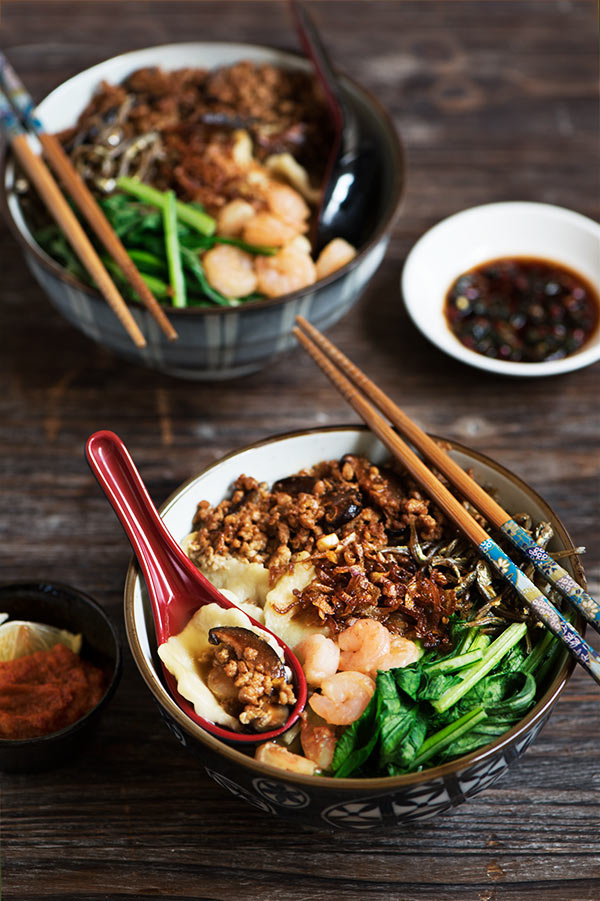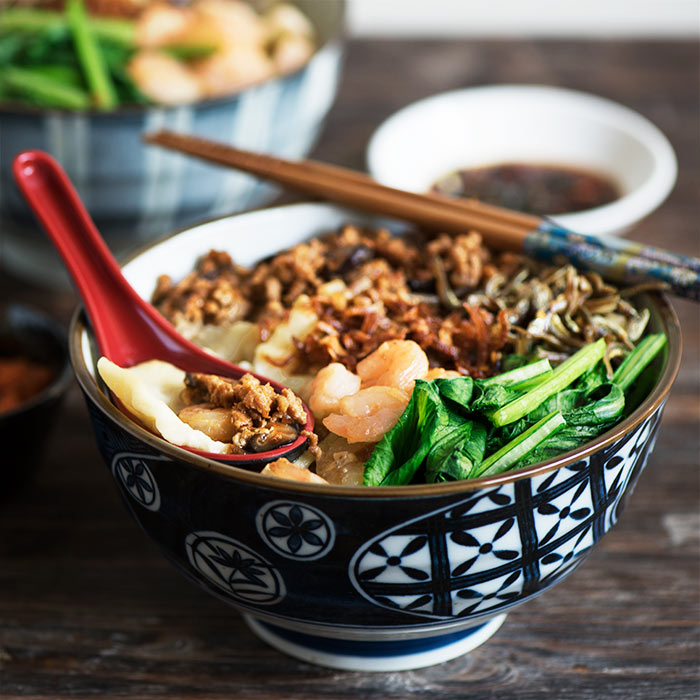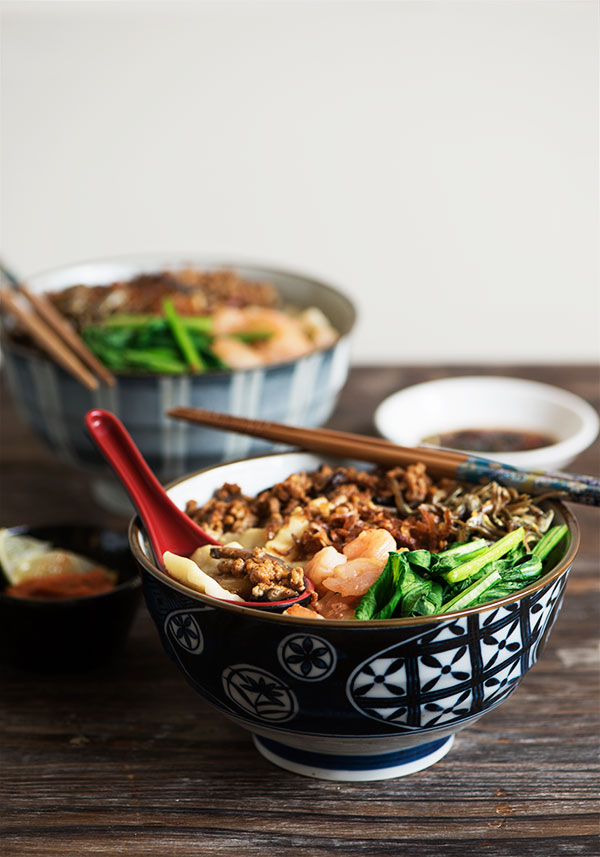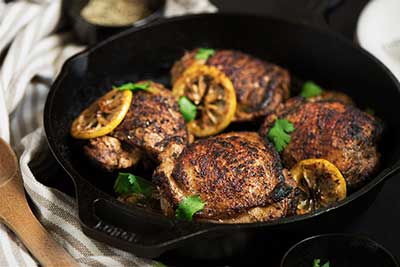When one has three girls in the family, you put them to work. At least that was what my parents did. My sisters and I each had our own chores to do. No, they weren’t paid. Chores that were our responsibility. We took turns with dishes and cleaning and helped with laundry and cooking.
There were some chores that we get paid for but they were more difficult or time consuming and it was up to us if we wanted to do it.
Weekends were the busiest time in my family. My parents would stock up on food for the entire week. So you can imagine.. there was a lot to do. Sometimes Often, I would dread helping out. I was a lazy child after all. But I’m now grateful for the life lessons… for the experiences. Mr. V would be starving if it wasn’t for them.
The only thing I’d look forward to on weekends are cartoons, Oprah and the food my parents would make. The special kind of food that I would not necessarily get on weekdays. One of which was my all time favorite homemade noodles.
“Mee Hoon Kueh” (pronounced as me who-n coo eh).
It’s a type of Chinese, or more specific, Hokkien soup noodles. A simple noodle dough is ‘hand-torn’ into bite size and cooked in anchovies broth.
Because the noodles are hand torn, each shape is different. When cooked right, they are silky smooth, lightly chewy and bouncy with a slight al dente bite. Topped with delicious pork and mushroom, shrimp, fried anchovies and fried shallots, it’s truly heaven in a bowl.
Once I knew that we were having Mee Hoon Kueh for lunch, I’d turn into this super efficient child, helping out with everything I was allowed to in hopes to lighten the workload so that my mom can start making lunch already.

For me, Mee Hoon Kueh is the epitome of comfort food. It brings me memories of my old house. Of pure joy and simplicity in life. I’d sit on the floor to knead and throw the dough. Yes, throw. That was my job and I loved it.
The smell of anchovies broth would fill the entire house. I’d watch my mom hand tear the noodles skillfully into hot, boiling broth and wondered when I’d be able to do that just like her.
When lunchtime came, my sisters and I would customize our own bowl of noodles. One would add marmite to the soup, the other may have it just plain. I always have mine with sambal and would easily devour 2-3 huge bowls of this.
I’ve eaten my share of noodles and honestly, this type of noodles is still one of the best kind there is. Besides, making it at home is simple enough. No gadgets required. Just your hands. Brilliant. And the anchovies broth… sounds simple enough but when the flavors from the toppings are all mixed with it, you’re going to be blown away.

Also, if you haven’t already, check out my last post. Nando’s Lemon & Herb Chicken. Juicy, delicious and addictive Nando’s Lemon & Herb Chicken copycat. Infused with plenty of lemon flavor, aromatic herbs and spices.
Check out the video on how I ‘tear’ the noodles.
Malaysian Hand-Torn Noodles (Mee Hoon Kueh or Pan Mee) Serves 4
Dough:
17 oz all purpose flour (4 cups scoop and sweep)
2 tsp salt
2 large eggs
8 oz water (1 cup)
Broth:
3/4 cup (6 oz) anchovies
8 cups water
Meat and Mushroom Topping:
1/2 tsp oil
1/2 lb ground pork
3 garlic cloves
4 small (1/2 oz) shiitake mushrooms, soaked in hot water and sliced
1 tbs soy sauce
1/2 tbs oyster sauce
1/2 tbs thick caramel sauce or kecap manis (for color)
1/8 tsp sugar
1/8 tsp salt
Few drops sesame oil
Pinch of white pepper
2 tbs water or mushroom water
Garlic Shrimp Topping:
1/2 cup (6 oz) small shrimp
2 garlic cloves, finely minced
Salt and pepper, to taste
16 oz yu choy or baby bok choy or any green vegetables, cut into 2″ long
Garnish:
1/4 cup fried anchovies
3 tbs fried shallots
Sambal (optional)
Red chilies or Thai bird’s eye chili in soy sauce (optional)
Lime wedges (optional)
directions:
Making the dough
1. In a large bowl, whisk the flour and salt together. Make a hole in the center and crack the eggs. Mix the egg with the flour.
2. Add 1 cup of water and mix. Add more water as needed to form a dough. You’re looking for a dough that’s as soft as possible with a some stickiness. The stickiness will subside as you knead it.
Too dry dough makes it hard to achieve the required thickness when making noodles later since it won’t be as flexible. If you accidentally added too much water, just lightly dust with flour while kneading. Too wet a dough also makes it hard to handle the dough later. Add more flour if it’s too wet.
3. Knead the dough for 8-10 minutes until elastic. Pick up the dough and throw onto the work surface 10 times in between kneading the dough. Do this 3-4 times through kneading time. You’ll immediately notice that throwing the dough helps it become smooth and elastic.
4. Place dough in a bowl and cover with a sling wrap. Let rest for at least 1 hour. Resting the dough helps noodles soften more.
Making the broth
1. In a large pot, add the anchovies and water. Bring the water to boil over high heat.
2. Once boiled, add 1 1/2 tsp salt, turn the heat to medium and let simmer uncovered for 15 minutes.
3. Use a slotted spoon to remove the anchovies. Turn heat off and set aside.
Meat and Mushroom Topping
1. Heat a pan over high heat. Once hot, add the oil and fry the garlic. When the garlic has turn light brown (super fast), brown the meat. When the meat is almost cooked, add the mushroom. Fry for a couple more minutes.
2. Turn the heat to medium high and add the soy sauce, oyster sauce, thick caramel sauce, sugar, salt, sesame oil and white pepper. Stir to combine well. The meat and mushroom will start to absorb the sauce. Add the water, taste and adjust seasoning (if necessary). Remove from heat and set aside.
Garlic Shrimp Topping
1. Heat a pan over medium high heat. Add a thin coat of oil and brown the garlic. Once they turn light brown, add the shrimp. Season with salt and pepper. Fry until shrimp turns pink and is cooked through. Add a little water just so the shrimp is slightly moistened. Remove from heat and set aside.
Cooking the Noodles
1. Heat a large pot of water (we need space for noodles to cook more evenly). Add some salt. Once the water comes to a boil, maintain heat at medium high.
2. Divide the dough into two (dividing just makes it easier to hold and cook the noodles). Hold the dough in your hand. Working from the top, press the dough as thin as you can while stretching it. Once you get a rough bite size, tear it off and drop it into the broth to cook.
Press and stretch the noodles as even and thin as you can (about 1/16″ or 2 mm) especially the edges for even cooking. If the dough tears, just pinch it back up and redo. Noodles will puff slightly when cooked.
3. Once the noodles start to float, let cook for 1-2 more minutes (depending on the thickness and size). If you’re not sure, cut one in half. If it’s still white in the middle, it isn’t fully cooked. Remove cooked noodles with a slotted spoon and set aside.
You’ll have to press, stretch and tear the dough whilst eyeballing the cooked noodles and remove them with a slotted spoon.
4. Once all the dough is cooked, bring the broth back to a rolling boil, add the vegetables and the cooked noodles (just to heat them up a little). Season soup with salt and pepper (keep in mind that the meat and shrimp as well as the fried shallots and anchovies will impart more flavor into the soup).
To Assemble
Add noodles, vegetables and soup into a bowl. Top with meat and mushroom, shrimp, fried anchovies and fried shallots. Serve immediately as is, or with a squeeze of lime or with chili or sambal.
Notes:
1. Koreans use big and fat 2-3″ anchovies but the head and gut needs to be removed as they impart a sour taste. On the other hand, my mom has been using smaller sized and thinner (1 1/2″) anchovies without removing the heat and gut when making the broth, so I follow suit.
2. Another version similar to this noodle is called ‘Pan Mee’ where the dough is cut into long straight strands (either by knife or a pasta machine) instead. In Malaysia, most hawker stalls would sell the latter version as the former is more difficult and more time consuming to make.
So if you find tearing the noodles a little difficult and you have a pasta machine, simply roll and cut it up into your desired width. No machine? Roll and flatten the dough until it’s about 1/8″ (or less). Fold the dough into layers and cut it into bite size. Remember to dust the dough and noodles liberally.
3. Fried anchovies are anchovies that are deep fried until crisp, drained, cooled and stored in a jar. You can keep them in the refrigerator or a cool, dark place for a couple of weeks or a few months.



9 comments
So that’s what they’re officially called! We call them Mao Er Duo (Cat Ear) Soup but no one else seems to call it that.
So whenever I bring up the name of my favorite food, people tend to look at me with horror… Thanks for clearing that up.
Pan mee is my absolute favorite noodle dish. Absolute. Especially hand torn noodles.
*WIDEST GRIN EVER* Are you Malaysian?
Yes. Can’t you tell from my rojak face? 🙂 Another one of my favorite, by the way, and not something I can easily find here, unfortunately.
Lol no….. it’s just no one will ever say I love Pan Mee unless they’re Malaysian. :p I LOVE ROJAK TOO!
Do you have the recipe for the ‘green chili’ sauce that’s usually served with it at the stalls? For me, pan mee is just not complete without it.
Hey Cait. Honestly, I’ve only seen the ones where red chili sauce is served which I believe it’s some variation of sambal (only no ‘tumis’ aka frying is necessary). Also, I’ve never made green chili sauce before. If I’ve to guess what goes in it, it’s probably blended fresh chilies, ginger, garlic and lime juice. Lemongrass and shallots would be optional. Perhaps some would add tomato or red bell pepper. And instead of lime juice, vinegar is used. Since you like the green type, use green chilies. Hope this helps.
YUM! I love the idea of making hand torn noodles – I have never tried it before but will give your recipe a go for sure when I get time. The ingredients list looks like these noodles would just be totally packed with flavour too. I know what you mean about comfort food – I guess we all have specific meals we associate with growing up and eating at home, and its lovely that you can still recreate this.
Thanks Claudia. Indeed, everyone’s comfort food is different and personal to each. Jamie Oliver’s Comfort Food book shows a glimpse of just that.